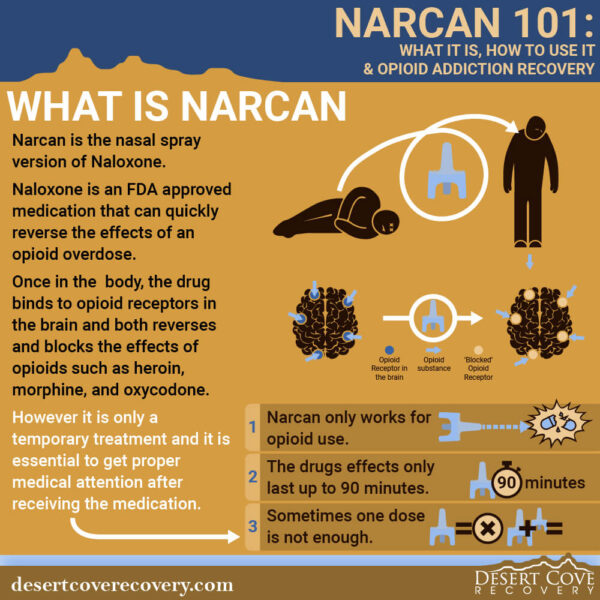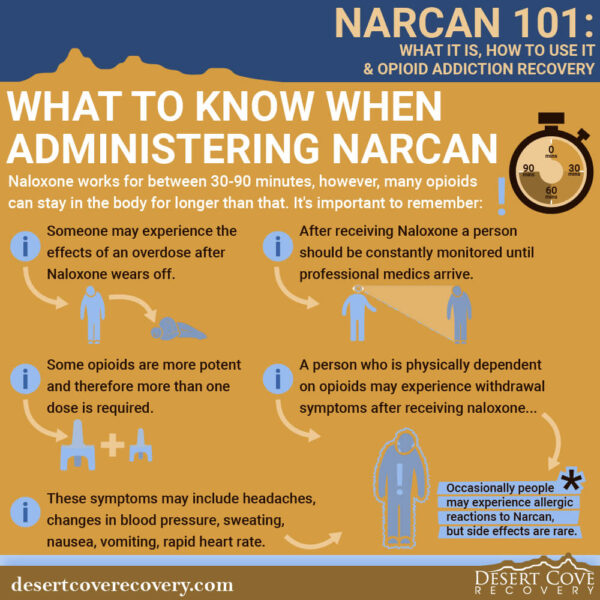Narcan for opioid overdose can start the process for someone seeking opioid addiction recovery. Opioid abuse is a significant problem in the United States as statistics show that in 2019 an estimated 10 million people over the age of 12 misused opioids. [1]
The issue has become so prevalent that in 2017, the U.S. Department of Health and Human Services declared a public health emergency to bring attention to it. Despite this, the estimated overdose deaths from opioids increased to 75,673 in the 12-months ending in April 2021. That’s up from 56,064 the year before. [2]
To help decrease the number of opioid-related deaths, medical personnel, EMTs, and others administer Narcan when they believe a person is experiencing an opioid overdose. While this can prevent overdose death, it is not a cure for addiction. Treatment and opioid addiction recovery services are the only way to overcome a substance abuse disorder.
What is Narcan, and How Can It Help with Opioid Addiction Recovery?
Narcan, or Naloxone, is an FDA-approved medication to reverse opioid overdose quickly. [3] Narcan is the nasal spray version of the medication. Once naloxone enters the body, it binds to opioid receptors and reverses and blocks the effects of opioids such as heroin, morphine, and oxycodone. Narcan can quickly restore normal breathing to someone who has stopped breathing or whose breathing has slowed because of an opioid overdose.
Narcan is given when someone is showing signs of an opioid overdose and is a temporary treatment. It is crucial to get medical attention right after receiving the medication. When using Narcan, it’s important to remember the following:
- Narcan only works for opioid use.
- The effects only last up to 90 minutes.
- Sometimes one dose is not enough.
Narcan is also not a treatment for an opioid use disorder. It is only used to attempt to reverse an opioid overdose. Many people assume that Narcan can treat a substance abuse disorder. It is only a temporary fix to a problem that needs to be treated more in-depth to help a person with an addiction truly.
Many pharmacies now carry Naloxone. Depending on where you live, you may or may not need a prescription. Many local health departments and community-based groups often distribute Narcan to combat opioid overdoses for free.
How Do You Administer Narcan / Naloxone?
Naloxone can be administered as a nasal spray or injected into the muscle under the skin.
Naloxone Nasal Spray
In this method, someone sprays Narcan into one nostril while the person overdosing lays on their back. This is often the easiest way to administer the medication, especially for those without medical training. [4]
Injectable Naloxone
Naloxone is injected with a needle into the muscle, and it can also be given into a vein or under the skin. Usually, the dose needs to be given from a vial. Sometimes this method can be difficult to administer for those with no medical background. In some states, people can seek training to administer naloxone in this way.
Either method can effectively reverse an opioid overdose, but one 2019 study suggested that naloxone devices can be more effective by delivering higher blood levels of naloxone than nasal devices. [4]
What do I Need to Know When Administering Narcan?
Naloxone only works for 30-90 minutes after it’s given to the patient. Many opioids can stay in the body for much longer. That’s why it’s important to remember: [4]
- Someone may experience the effects of an overdose after naloxone wears off.
- Since some opioids are more potent, they may require more than one dose.
- After administering naloxone, the person should be constantly monitored until professional medical help arrives.
- Someone who is physically dependent on opioids can have withdrawal symptoms within minutes after receiving naloxone.
- Withdrawal symptoms can include headaches, changes in blood pressure, sweating, nausea, vomiting, rapid heart rate.
Some people may experience allergic reactions to Narcan, but side effects are rare.
Opioid Addiction Recovery at Desert Cove Recovery
While Narcan can help reverse an opioid overdose and prevent death, it is not a form of treatment for opioid use disorder. Seeking opioid addiction recovery services, like those offered at Desert Cove Recovery, is the best way to get on the path to sobriety.
At Desert Cove Recovery, patients receive customized drug treatment programs depending on their level of dependency. The length of the treatment program will vary from person to person. Programs typically consist of various therapies, including those to treat the mind and the body.
If you or a loved one is looking to treat opioid addiction, let Desert Cove Recovery help. Our experienced team is available 24/7 for support. Contact us today by phone or online to get started.
Sources:
[1] https://www.hhs.gov/opioids/about-the-epidemic/opioid-crisis-statistics/index.html [2] https://www.cdc.gov/nchs/pressroom/nchs_press_releases/2021/20211117.htm [3] https://www.samhsa.gov/medication-assisted-treatment/medications-counseling-related-conditions/naloxone [4] https://nida.nih.gov/publications/drugfacts/naloxone







